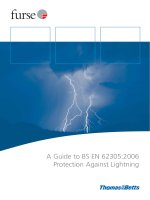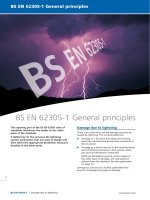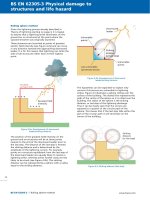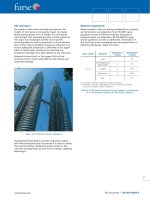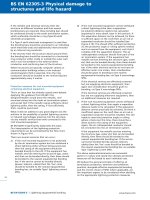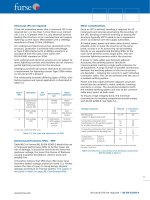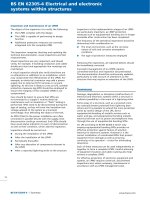Bsi bs en 02155 21 1989 (2000)
Bạn đang xem bản rút gọn của tài liệu. Xem và tải ngay bản đầy đủ của tài liệu tại đây (478.59 KB, 12 trang )
BRITISH STANDARD AEROSPACE SERIES
Test methods for
transparent materials
for aircraft glazing —
Part 21: Determination of resistance to
crack propagation (K factor)
This European Standard EN 2155-2 has the status of a
British Standard.
UDC 629.73.023.26:620.191.33
BS EN
2155-21:1989
BS EN 2155-21:1989
Cooperating organizations
The European Committee for Standardization, under whose supervision this
European Standard was prepared, comprises the national standards
organizations of the following Western European countries.
Austria
Belgium
Denmark
Finland
France
Germany
Greece
Iceland
Ireland
Italy
Luxemburg
Netherlands
Norway
Portugal
Spain
Sweden
Switzerland
United Kingdom
This British Standard, having
been prepared under the
direction of the Aerospace
Standards Policy Committee,
was published under the
authority of the Board of BSI
and comes into effect on
31 October 1989
© BSI 01-2000
The following BSI references
relate to the work on this
standard:
Committee reference ACE/62
Draft for comment 88/70404 DC
ISBN 0 580 17926 5
Oesterreichisches Normungsinstitut
Institut belge de normalisation
Dansk Standardiseringsraad
Suomen Standardisoimisliito, r.y.
Association franỗaise de normalisation
Deutsches Institut für Normung e.V.
Hellenic Organization for Standardization
Icelandic Council for Standardization
National Standards Authority of Ireland
Ente Nazionale Italiano di Unificazione
Inspection des travails et des mines
Nederlands Normalisatie-instituut
Norges Standardiseringsforbund
Instituto Português da Qualidade
Instituto Español de Normalización
Standardiseringskommissionen i Sverige
Association suisse de normalisation
British Standards Institution
Amendments issued since publication
Amd. No.
Date of issue
Comments
BS EN 2155-21:1989
Contents
Cooperating organizations
National foreword
Brief history
Text of EN 2155-21
National appendix A
© BSI 01-2000
Page
Inside front cover
ii
2
3
Inside back cover
i
BS EN 2155-21:1989
National foreword
This British Standard has been prepared under the direction of the Aerospace
Standards Policy Committee and is the English language version of
EN 2155 “Aerospace series. Test methods for transparent materials for aircraft
glazing” Part 21 “Determination of resistance to crack propagation (K factor)”
published by the European Committee for Standardization (CEN). EN 2155-21
was produced as a result of international discussion in which the UK took an
active part.
A British Standard does not purport to include all the necessary provisions of a
contract. Users of British Standards are responsible for their correct application.
Compliance with a British Standard does not of itself confer immunity
from legal obligations.
Summary of pages
This document comprises a front cover, an inside front cover, pages i and ii,
the EN title page, pages 2 to 6, an inside back cover and a back cover.
This standard has been updated (see copyright date) and may have had
amendments incorporated. This will be indicated in the amendment table on the
inside front cover.
ii
© BSI 01-2000
EN 2155-21
EUROPEAN STANDARD
NORME EUROPÉENNE
EUROPÄISCHE NORM
March 1989
UDC: 629.73.023.26:620.191.33
Key words: Aircraft industry, glazing, transparent plastics, glass, tests, strength, crack propagation
English version
Aerospace series
Test methods for transparent materials
for aircraft glazing
Part 21: Determination of resistance
to crack propagation (K factor)
Luft- und Raumfahrt
Prüfverfahren für transparente Werkstoffe
zur Verglasung von Luftfahrzeugen
Teil 21: Bestimmung des
Ri¶fortpflanzungswiderstandes (K-Faktor)
Série ắrospatiale
Méthodes d’essais pour matériaux
transparents pour vitrages aéronautiques
Partie 21: Détermination de la résistance
à la propagation des criques (Facteur K)
This European Standard was accepted by CEN on 1988-03-17. CEN members
are bound to comply with the requirements of CEN Internal Regulations which
stipulate the conditions for giving this European Standard the status of a
national standard without any alteration.
Up-to-date lists and bibliographical references concerning such national
standards may be obtained on application to the CEN Central Secretariat or to
any CEN member.
This European Standard exists in three official versions (English, French,
German). A version in any other language made by translation under the
responsibility of a CEN member into its own language and notified to CEN
Central Secretariat has the same status as the official versions.
CEN members are the national standards organizations of Austria, Belgium,
Denmark, Finland, France, Germany, Greece, Iceland, Ireland, Italy,
Luxemburg, Netherlands, Norway, Portugal, Spain, Sweden, Switzerland and
United Kingdom.
CEN
European Committee for Standardization
Comité Européen de Normalisation
Europäisches Komitee für Normung
Central Secretariat: rue de Stassart 36, B-1050 Brussels
© CEN 1989 Copyright reserved to all CEN members
Ref. No. EN 2155-21:1989 E
EN 2155-21:1989
Brief history
This European Standard has been prepared by the
European Association of Aerospace Manufacturers
(AECMA).
After enquiries and votes carried out in accordance
with the rules of this Association, this Standard has
successively received the approval of the National
Associations and the Official Services of the member
countries of AECMA, prior to its presentation to
CEN.
According to the Common CEN/CENELEC Rules,
following countries are bound to implement this
European Standard: Austria, Belgium, Denmark,
Finland, France, Germany, Greece, Iceland,
Ireland, Italy, Luxemburg, Netherlands, Norway,
Portugal, Spain, Sweden, Switzerland and the
United Kingdom.
2
Contents
Brief history
1
Scope and field of application
2
Definitions
3
Apparatus
4
Specimens
5
Conditioning
6
Procedure
7
Expression of results
8
Test report
Figure 1 — Driving yoke and blade for
initiating cracks in toughness specimens
Figure 2 — Toughness specimen
Figure 3 — The fracture zones on
a failed specimen
Table 1 — Values of Z
Page
2
3
3
3
3
3
3
3
4
4
5
5
6
© BSI 01-2000
EN 2155-21:1989
1 Scope and field of application
This standard specifies how the resistance to crack
propagation of rigid transparent sheet is to be
determined.
2 Definitions
Resistance to crack propagation is defined either by
fracture toughness K at failure, or by strain energy
¹W
release rate ¹ A at failure.
The values of failing load and length of crack at fast
fracture shall be determined by tensile tests with a
specified constant rate loading using a pre-cracked
standard specimen.
3 Apparatus
3.1 A tensile testing machine shall be provided such
that the specimen can be loaded at a constant rate
which will cause fracture in 3 to 5 min.
3.2 Suitable grips shall be provided on this machine
of sufficient width to grip the specimen i.e. at
least 50 mm in width. Self-tightening wedge grips
have been found suitable but great care shall be
taken to avoid damaging the specimen.
3.3 A driving yoke and blade for initiating cracks in
the specimens shall be provided to the dimensions
as illustrated in Figure 1.
4 Specimens
Test specimens shall conform to Figure 2. The
specimen’s width shall be measured to the
nearest 0,2 mm and their thickness at the centre
shall be measured to the nearest 0,02 mm. Five
specimens shall be cut from each sample.
5 Conditioning
5.1 For testing at (23 ± 2) ° C, (50 ± 5) % relative
humidity the specimens shall be conditioned for at
least 48 h at this condition prior to testing.
5.2 For testing at (– 18 ± 1) ° C the specimens shall
be conditioned at this temperature for at
least 30 min prior to testing.
6 Procedure
The distance between the heads of the initial cracks
shall be between 12,5 mm and 25,0 mm so that the
crack length at the point of instability will be
between 1/4 and 1/2 of the specimen width. In
initiating the cracks, the following procedure is
recommended. A fine slot, approximately 0,8 mm
deep is made with a jeweller’s saw. The driving yoke
and blade shown in the Figure 1 are employed in
initiating the cracks.
With the specimen held firmly in a vertical position
with its length horizontal, the blade is inserted
through the central hole and seated in the saw cut.
The yoke straddles the specimen and engages the
blade in the squared notches.
A light hammer tapping on the yoke is used to
initiate the crack.
Cracks shall be initiated under conditions of
conditioning according to clause 5.1 for testing
under these conditions. For low temperature
testing, cracks are initiated prior to conditioning at
low temperature according to clause 5.2 .
6.3 Gripping and loading
The specimen shall be gripped to
approximately 25 mm from the ends. Care shall be
taken to ensure proper alignment of the specimen.
The specimen shall be loaded at a constant rate that
will cause failure in 3 to 5 min; (2,8 ± 0,5) kN/min
will be suitable for most thicknesses.
6.4 Crack length
The failing load, crack length at onset of fast
fracture and test temperature shall be recorded. The
crack length at onset of fast fracture may be
determined by closely following the progress of the
crack front during slow fracture and examination of
the fracture surface (Figure 3 refers).
The average crack length shall be recorded to the
nearest 0,2 mm. Figure 3 is a sketch of the cross
section of the specimen after failure taken at the
centreline of the hole.
7 Expression of results
7.1 Fracture toughness
Fracture toughness K shall be computed from the
equation:
6.1 The resistance to crack propagation (toughness)
of the material shall be determined as follows:
6.2 Initiation of cracks
Cracks shall be initiated on opposite sides of the
centrally located hole in the specimen so as to be
oriented in the width direction.
© BSI 01-2000
3
EN 2155-21:1989
7.2 Strain energy release rate
An alternative method of assessment is to use strain
¹W
energy release rate ¹ A computed from the
equation:
Dimensions in millimetres
where:
P = failure load in N
t = thickness of the specimen in mm
B = specimen width in mm
of elasticity in MPa, determined in
E = amodulus
tensile test under a stress of 10 MPa
; = 3,141
Z =
(see Table 1)
Y = ---XB
X = crack length at onset of fracture in mm
W = strain energy
A = fracture area
8 Test report
The test report shall include:
8.1 the fracture toughness expressed in MPa.mm1/2
at (23 ± 2) °C and at (– 18 ± 1) °C.
8.2 and/or the strain energy release rate expressed
in kJ/m2 at (23 ± 2) °C and at (– 18 ± 1) °C.
4
Figure 1 — Driving yoke and blade for
initiating cracks in toughness specimens
© BSI 01-2000
EN 2155-21:1989
Dimensions in millimetres
Figure 2 — Toughness specimen
D imensions in millimetres
Figure 3 — The fracture zones on a failed specimen
© BSI 01 - 2 000
5
EN 2155-21:1989
Table 1 — Values of Z
Example: When Y = X
---- = 0,146, Z = 0,0746
B
Y
0,070
0,080
0,090
0,100
0,110
0,120
0,130
0,140
0,150
0,160
0,170
0,180
0,190
0,200
0,210
0,220
0,230
0,240
0,250
0,260
0,270
0,280
0,290
0,300
0,310
0,320
0,330
0,340
0,350
0,360
0,370
0,380
0,390
6
O
0,0352
0,0403
0,0454
0,0505
0,0557
0,0609
0,0661
0,0714
0,0768
0,0822
0,0876
0,0931
0,0987
0,1044
0,1101
0,1159
0,1219
0,1279
0,1340
0,1402
0,1466
0,1531
0,1597
0,1665
0,1735
0,1807
0,1880
0,1955
0,2033
0,2113
0,2196
0,2281
0,2370
1
0,0357
0,0408
0,0459
0,0510
0,0562
0,0614
0,0667
0,0720
0,0773
0,0827
0,0882
0,0937
0,0993
0,1049
0,1107
0,1165
0,1225
0,1285
0,1346
0,1409
0,1472
0,1538
0,1604
0,1672
0,1742
0,1814
0,1887
0,1963
0,2041
0,2121
0,2204
0,2290
0,2379
2
0,0362
0,0413
0,0464
0,0515
0,0567
0,0619
0,0672
0,0725
0,0778
0,0833
0,0887
0,0942
0,0998
0,1055
0,1113
0,1171
0,1231
0,1291
0,1352
0,1415
0,1479
0,1544
0,1611
0,1679
0,1749
0,1821
0,1895
0,1971
0,2049
0,2129
0,2213
0,2299
0,2388
3
0,0367
0,0418
0,0469
0,0521
0,0572
0,0625
0,0677
0,0730
0,0784
0,0838
0,0893
0,0948
0,1004
0,1061
0,1119
0,1177
0,1237
0,1297
0,1359
0,1421
0,1485
0,1551
0,1617
0,1686
0,1756
0,1828
0,1902
0,1979
0,2057
0,2138
0,2221
0,2307
0,2397
4
0,0372
0,0423
0,0474
0,0526
0,0578
0,0630
0,0683
0,0736
0,0789
0,0843
0,0898
0,0953
0,1010
0,1067
0,1124
0,1183
0,1243
0,1303
0,1365
0,1428
0,1492
0,1557
0,1623
0,1693
0,1763
0,1836
0,1910
0,1986
0,2065
0,2146
0,2230
0,2316
0,2406
5
0,0377
0,0428
0,0479
0,0531
0,0583
0,0635
0,0688
0,0741
0,0795
0,0849
0,0904
0,0959
0,1015
0,1072
0,1130
0,1189
0,1249
0,1309
0,1371
0,1434
0,1498
0,1564
0,1630
0,1700
0,1771
0,1843
0,1917
0,1994
0,2073
0,2154
0,2238
0,2325
0,2415
6
0,0382
0,0433
0,0485
0,0536
0,0588
0,0640
0,0693
0,0746
0,0800
0,0854
0,0909
0,0965
0,1021
0,1078
0,1136
0,1195
0,1255
0,1315
0,1377
0,1440
0,1505
0,1571
0,1637
0,1707
0,1778
0,1850
0,1925
0,2002
0,2081
0,2162
0,2247
0,2334
0,2424
7
0,0387
0,0438
0,0490
0,0541
0,0593
0,0646
0,0698
0,0752
0,0805
0,0860
0,0915
0,0970
0,1027
0,1084
0,1142
0,1201
0,1261
0,1321
0,1384
0,1447
0,1511
0,1577
0,1644
0,1714
0,1785
0,1858
0,1933
0,2010
0,2089
0,2171
0,2255
0,2343
0,2433
8
0,0392
0,0443
0,0495
0,0546
0,0598
0,0651
0,0704
0,0757
0,0811
0,0865
0,0920
0,0976
0,1032
0,1090
0,1148
0,1207
0,1267
0,1328
0,1390
0,1453
0,1518
0,1584
0,1651
0,1721
0,1792
0,1865
0,1940
0,2017
0,2097
0,2179
0,2264
0,2352
0,2443
9
0,0398
0,0449
0,0500
0,0552
0,0604
0,0656
0,0709
0,0762
0,0816
0,0871
0,0926
0,0982
0,1038
0,1095
0,1154
0,1213
0,1273
0,1334
0,1396
0,1460
0,1524
0,1594
0,1658
0,1728
0,1799
0,1873
0,1948
0,2025
0,2105
0,2187
0,2273
0,2361
0,2452
© BSI 01-2000
BS EN 2155-21:1989
National appendix A
The United Kingdom participation in the preparation of this European Standard was entrusted by the
Aerospace Standards Policy Committee (ACE/-) to Technical Committee ACE/62 upon which the following
bodies were represented:
British Plastics Federation
Ministry of Defence
Society of British Aerospace Companies Limited
© BSI 01-2000
BS EN
2155-21:1989
BSI — British Standards Institution
BSI is the independent national body responsible for preparing
British Standards. It presents the UK view on standards in Europe and at the
international level. It is incorporated by Royal Charter.
Revisions
British Standards are updated by amendment or revision. Users of
British Standards should make sure that they possess the latest amendments or
editions.
It is the constant aim of BSI to improve the quality of our products and services.
We would be grateful if anyone finding an inaccuracy or ambiguity while using
this British Standard would inform the Secretary of the technical committee
responsible, the identity of which can be found on the inside front cover.
Tel: 020 8996 9000. Fax: 020 8996 7400.
BSI offers members an individual updating service called PLUS which ensures
that subscribers automatically receive the latest editions of standards.
Buying standards
Orders for all BSI, international and foreign standards publications should be
addressed to Customer Services. Tel: 020 8996 9001. Fax: 020 8996 7001.
In response to orders for international standards, it is BSI policy to supply the
BSI implementation of those that have been published as British Standards,
unless otherwise requested.
Information on standards
BSI provides a wide range of information on national, European and
international standards through its Library and its Technical Help to Exporters
Service. Various BSI electronic information services are also available which give
details on all its products and services. Contact the Information Centre.
Tel: 020 8996 7111. Fax: 020 8996 7048.
Subscribing members of BSI are kept up to date with standards developments
and receive substantial discounts on the purchase price of standards. For details
of these and other benefits contact Membership Administration.
Tel: 020 8996 7002. Fax: 020 8996 7001.
Copyright
Copyright subsists in all BSI publications. BSI also holds the copyright, in the
UK, of the publications of the international standardization bodies. Except as
permitted under the Copyright, Designs and Patents Act 1988 no extract may be
reproduced, stored in a retrieval system or transmitted in any form or by any
means – electronic, photocopying, recording or otherwise – without prior written
permission from BSI.
This does not preclude the free use, in the course of implementing the standard,
of necessary details such as symbols, and size, type or grade designations. If these
details are to be used for any other purpose than implementation then the prior
written permission of BSI must be obtained.
BSI
389 Chiswick High Road
London
W4 4AL
If permission is granted, the terms may include royalty payments or a licensing
agreement. Details and advice can be obtained from the Copyright Manager.
Tel: 020 8996 7070.


